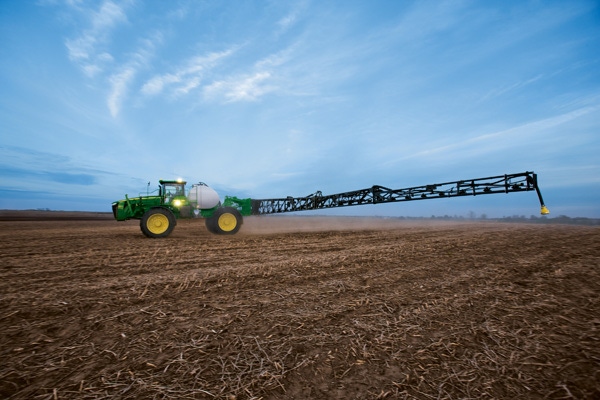March 12, 2012

Although it’s still too early to put a cap on the winter of 2011–12, for most parts of the Midwest, this year’s winter weather has been anything but wintery. And that has weed watchers putting out a word of caution: Early-season weed populations could be above normal, and weeds could reach advanced growth stages much earlier than usual. Farmers may need to purchase more weed control products and purchase them earlier this year.
“For weeds, this has so far been an ideal winter,” says Sarah Gehant, agronomic service representative with Syngenta. “We are seeing some additional growth and a thicker carpet of weeds. The percentage of weed seeds germinating is now pretty high, and they are getting an early start. So this means that not only will there be more weeds to control, but they will be taller.”
Spray herbicides earlier
Of course, a late cold snap could kill off weeds that break dormancy early, but mild weather into the early spring will mean producers need to closely monitor fields and move up their weed control programs. “Burndown applications should be targeted soon after dormancy break during good growing conditions for best results,” says Dan Westberg, BASF technical marketing manager. “Warmer conditions mean winter annual weeds may break dormancy earlier, so applications need to be applied earlier.”
Dawn Refsell, field marketing development specialist with Valent U.S.A. Corporation, says winter annuals, like marestail, could “bolt” earlier and become difficult to control. “You will want to target winter annuals when they are in the rosette stage, not when they are bolting,” she says. “By spraying in early spring, you can also prevent the winter annuals from producing seed and subsequently limiting the amount of weeds you will have to deal with in the future, since winter annual weed seeds are relatively short-lived in the soil.”
Add residual at preplant
Weed specialists say that an early start to the weeds doesn’t always correspond to an early planting date and therefore producers may need to adjust their spraying regimen. “Just because weeds emerge earlier doesn’t mean growers will necessarily plant earlier,” says Helen Flanigan, product development manager with DuPont. “Because weeds could have a significant head start before conditions are right for planting, growers should use a residual herbicide as part of their preplanting weed control program. Growers who use a simple contact herbicide burndown approach will likely see more weeds germinate before they are able to get back into the field to plant.”
Scouting early, and scouting often, is always recommended. But this year, your scouting calendar should be moved up. “Higher survival of winter annual and biennial species that emerged last year will mean weed densities will likely be higher, and the plants themselves might be larger by the time management practices are implemented,” says Aaron Hager, University of Illinois weed specialist. “Certainly scouting should be done before any preplant herbicide application is made. Producers should know what species are present and the size of the weeds before selecting a burndown herbicide. The only way to effectively select the product and the application rates is to know what’s growing and its size.”
Program options for growers depend on geography and weed pressure, but in general more northern geographies should consider a burndown application that also provides residual control. In more southern geographies, growers may need to apply a burndown application early and follow it with a residual application at planting.
“Winter annual weeds become very difficult to control once they reach the reproductive stage,” Westberg says. “Getting adequate spray coverage of weeds is also a major concern with large, dense weed populations.”
Overlapping residuals
In many cases there may be a need for overlapping residuals. Valent’s Refsell says, “For example, one program may be a preplant burndown application to remove winter annuals, followed by a preemergence application to provide residual control of resistant weeds such as Palmer amaranth and waterhemp.”
Even tillage may be necessary to effectively manage early-season weeds. “I suspect some may opt for tillage or herbicides, while some situations may necessitate both be used,” Hager says. “Whatever control program is used, it is imperative that all existing vegetation be controlled before any crop seeds are planted, and preferably before any of the winter annual weed species produce viable seeds.”
Multiple modes needed
Mixing in multiple modes of action in any weed control program is imperative. “I am all about redundancy for each application,” says Micheal Owen, weed scientist, Iowa State University. “Each mechanism of action needs to have activity on the target weeds, and preexisting resistances need to be factored in.”
Application timing will take on an even larger role. “Application timing is always a problem because many postemergence herbicide applications are made when weeds are well beyond 2 to 4 in. tall,” Owen says. “If growers are scouting effectively, timing should not be an issue. While weather can impact spray schedules, this can be mitigated by using a soil-applied residual herbicide.”
More than just weeds
Above-normal weed populations are more than a control concern; they can impact other crop management systems as well.
“Weeds use up soil nitrogen and other nutrients, taking them away from the crop,” says John Pawlak, product development manager for Valent. In addition, certain weeds, such as chickweed, henbit and purple deadnettle, can harbor insects detrimental to corn and soybeans. And in dry climates, weeds use moisture that may be needed for the crop.
“And by helping to eliminate established weeds and preventing new weeds from emerging, growers will have warmer, cleaner seedbeds,” Flanigan says. “That could help them get into the fields to plant a few days sooner.”
Waiting could put you at a significant disadvantage. “It is very likely that we will have weeds that get a jump on the growing season,” Gehant says. “We must get in at the labeled rate and height. With growth further along than normal, that means we will need to get into the fields earlier.”
About the Author(s)
You May Also Like






